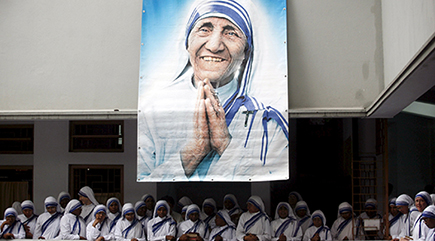
The humble founder of the Missionaries of Charity, champion of the poor will be declared a saint 19 years after her death
On March 15, Pope Francis presided over an Ordinary Public Consistory of Cardinals in the Vatican for the final approval for the canonization of several new saints. While there were a number of women and men being considered, most of the world’s attention has focused on just one of them: Blessed Mother Teresa of Kolkata, whose canonization will be held on Sept. 4 at the Vatican, with likely celebrations in Kolkata, India, where she is buried.
Ordinary consistories — public gatherings of the cardinals in the presence of the pope — are usually held for the creation of new members of the College of Cardinals, but they are also intended to advance causes for canonization or to give final approval for beatifications and canonizations. They are largely ceremonial events, but every so often the unexpected can happen. On Feb. 11, 2013, for example, Pope Benedict XVI announced his resignation from the papacy at the conclusion of a consistory for the canonization of several blesseds.
Pope Francis had no earth-shattering proclamations at the consistory on March 15, but the news coming out of the Consistory Hall in the Apostolic Palace still was extremely noteworthy.
One of the most beloved figures in the history of the Church, Mother Teresa died on Sept. 5, 1997, at the age of 87, and in 1999, Pope St. John Paul II waived the customary five-year waiting period before the start of a cause for canonization in answer to so many international appeals from the faithful. The cause officially began in the Archdiocese of Kolkata and was subsequently one of the swiftest in modern times.
Even as investigations into possible miracles through her intercession were taking place around the world, in 2001, on the feast of the Assumption of Mary on Aug. 15, officials closed the diocesan inquiry into her holiness and sent the case to the Congregation for the Causes of Saints in Rome. The main work of the cause then fell to Father Brian Kolodiejchuk, a Canadian priest who has served as the postulator, or chief advocate.
In 2002, the Congregation for the Causes of Saints recognized as a miracle the medically inexplicable healing of a tumor in the abdomen of a non-Christian Indian woman after members of the Missionaries of Charity prayed for their founder’s intercession. The healing took place on the first anniversary of Mother Teresa’s death.
Mother Teresa was beatified on Oct. 19, 2003, and Pope St. John Paul II, who had been a witness to the process, said of her, “How often, like the psalmist, did Mother Teresa call on her Lord in times of inner desolation: ‘In you, in you I hope, my God!’ Let us praise the Lord for this diminutive woman in love with God, a humble Gospel messenger and a tireless benefactor of humanity. In her, we honor one of the most important figures of our time.”
A second miracle was still needed for canonization. That occurred in 2008 and involved a Brazilian electrical engineer in his 30s who had suffered a viral brain infection that caused multiple abscesses and eventually left him in a terminal coma. His wife prayed for months for the intercession of Mother Teresa, and the man was miraculously healed.
Years of investigation followed, and only in September of last year did the cause’s medical commission vote unanimously that the cure was miraculous.
On Dec. 17, the Vatican publicly confirmed that Pope Francis had recognized the second miracle, ending speculation in Italian media that had been percolating for several months. Part of the speculation had been that Mother Teresa would be canonized on Sept. 4, 2016, the vigil of the 19th anniversary of her death and the day for the celebration of the Jubilee of Workers and Volunteers of Mercy. They were correct.
The canonization is expected to draw millions to Rome, and look for intense, sometimes hostile, media coverage of Mother Teresa’s labors and spiritual life.